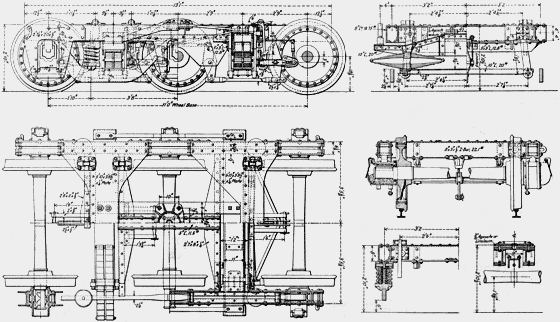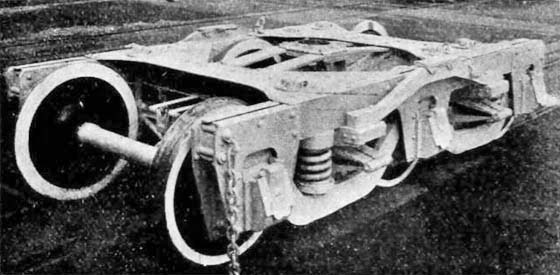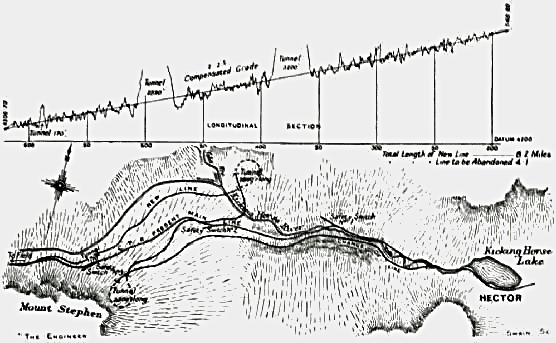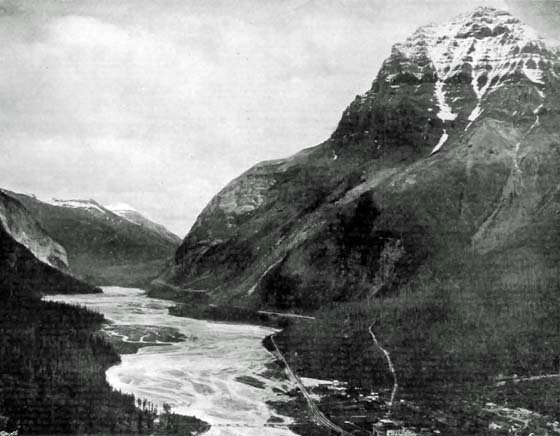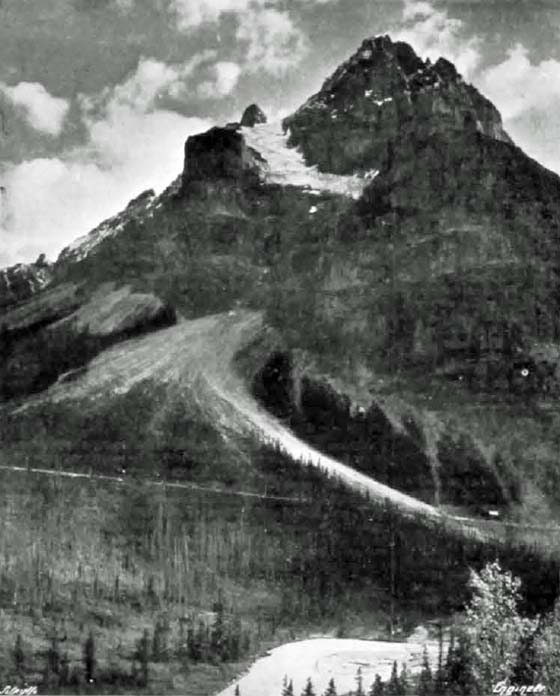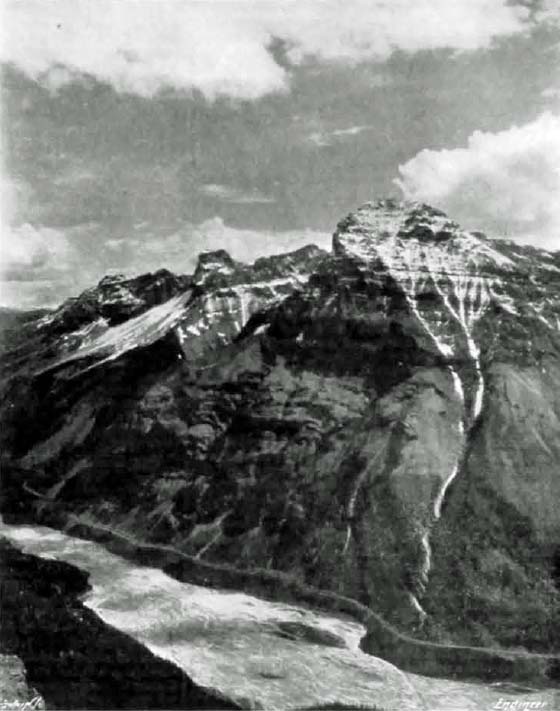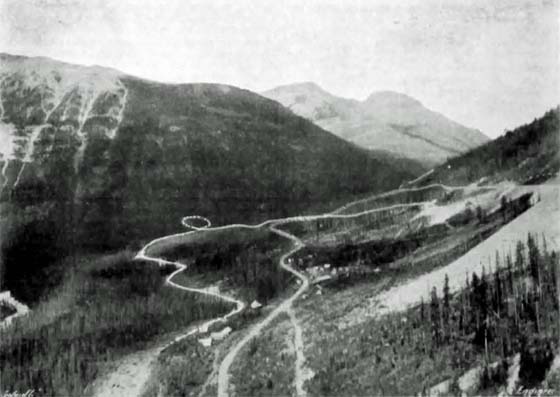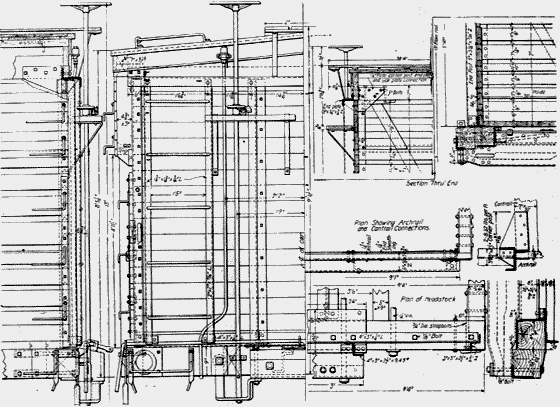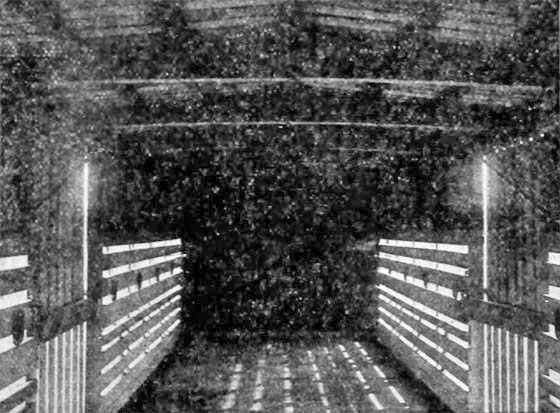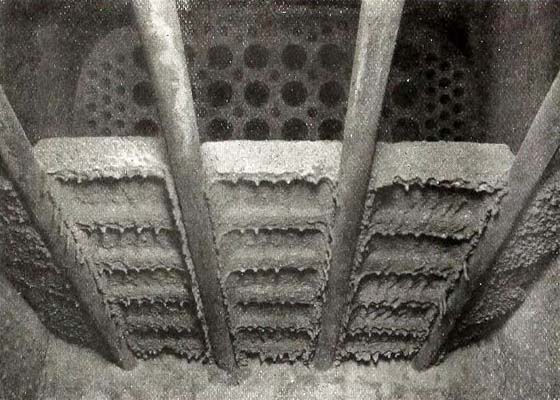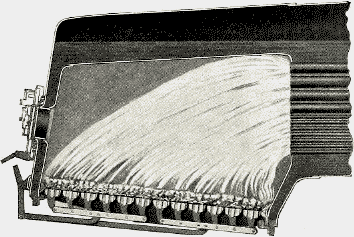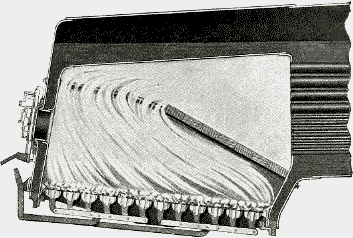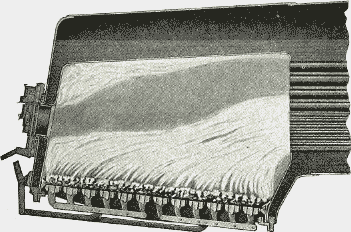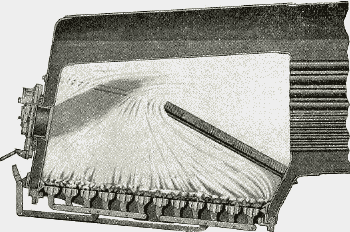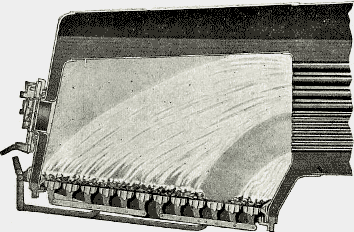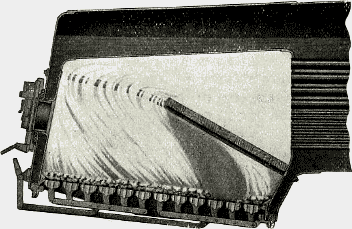 | Canadian Pacific Odds and Ends - Part 5 Articles |
Structural Steel Trucks Canadian Pacific Ry. - Railway Master Mechanic 1914. The "Last Call" page has appeared weekly on OKthePK's web site over the past couple of years. Each week a different article told the story about various railway items of interest. While some of the articles were saved they were no longer available online. Several of those about the Canadian Pacific Railway have been compiled here on this page. There is insufficient room to display more than a few articles per page. As a result, "Canadian Pacific Odds and Ends - Part 5", continues this month with more parts to follow as time progresses. Every month they will be archived to the CPR Set-off Siding web site for future online retrieval. Look under the articles section on the CPR Set-off Siding web site to find these archived pages. 
 Four Wheel Structural Steel Truck, C.P.R. By R.W. Burnett, G.M.C.B., Canadian Pacific Ry. On account of the faults common to all composite passenger trucks which cause unsatisfactory service and expense in maintenance, a design of a structural steel truck was prepared by the Canadian Pacific Railway about three years ago, with a view of overcoming these defects. All-metal trucks of cast steel construction have been used quite extensively during the past few years and have proven quite satisfactory. The first cost of the cast steel truck is considerably in excess of the composite trucks used heretofore. The structural steel truck is considered equal to the cast steel and is somewhat cheaper in the first cost and is also much easier and cheaper to repair, as in case of any breakage, due to accident or unusual conditions, it is only necessary to replace the damaged part, whereas with the cast steel truck, in cases of breakage it is necessary to replace the entire truck frame. In all attempts at designing a truck in the past, the side sill has been kept above the equalizer, while it has been necessary to keep the transoms down to clear center sills, draft rigging, brake gear, etc., making the use of an offset connection between transoms and side sill necessary. On this truck, the side sills are made of two channels with flanges together, the flanges being cut away to let the equalizers come up inside of the housing thus formed. The cutting away of the flanges is compensated for by the extension of the wing on the pedestal plate. The housing of the equalizer inside of the side sill makes it possible to drop the side sill so that it is flush with the transoms, doing away with the offset connection which has been used heretofore, and permitting the use of flat gusset plates above and below side sills and transoms, greatly increasing the strength and giving more room for inspection. The principal trouble with the composite trucks is the many parts bolted together requiring, constant attention, the frequent renewal of wooden parts that is necessary, and the wear of the different members. A composite truck made new, of the strongest design, will warp before being placed in service, so that the pedestals are not plumb on the boxes, and after a year's service the pedestals are spread all distances up to 2 inches. This built-up truck is made perfectly square and plumb and remains so. It has been noted that it requires less than one-half the power to move this truck than is required to move a composite truck on account of the composite truck getting out of square.
On this truck it has been found that there is strength to spare without end sills, which also allows the side sills to be made shorter, which gives better clearance at the steps and makes inspection of trucks, platforms, and draft gear easier. This strength is secured by the strength of the side sill and the clever arrangement of Gusset plates. The brakes are inside hung instead of outside hung, as with the ordinary six wheel truck it gives a more effective brake, also greatly reduces the tendency to tilt and surge, and leaves the ends free for inspection and free for any axle lighting system. The frequent breakage and rapid wear of cast iron pedestals is an old story. Experience with cast steel pedestals has shown that they not only wear out rapidly, but soon cut through the sides of the journal boxes. The built-up pedestal on this truck has a chilled iron filler riveted between the two plates. Experience has shown that in two years there is no appreciable wear and that the journal boxes are not injured. The cast iron pedestals do not add strength to the truck but the plate pedestal can be extended to act as a reinforcement, giving increased strength with reduction of weight.
It was thought, when these pedestals were designed, that as a matter of course they would bend in case of wreck, but in wrecks that would have broken cast iron pedestals, these pedestals have always brought the car home. In manufacturing, these pedestals are punched out, leaving about 3/16 inch inside of the jaw to be milled out. About twenty are milled at one time. They are drilled on a jig and are perfectly interchangeable. The time honoured pedestal strap, which required so much attention in inspection and repairs and caused so much annoyance when changing wheels, is not needed on these trucks on account of the strength of the side sill and pedestal. A small bar is pivoted on one arm of the back member of the pedestal and fastened to the other arm by a key bolt applied to prevent the box leaving pedestal if truck is jacked up or car is derailed. The brake rigging being on top of the axles, there are no nuts and only two cotters to remove to change any pair of wheels. Instead of the short jointed truck hangers ordinarily used, long hangers are used, the hangers on the four wheel truck being pivoted on top of the gusset plate while on the six wheel truck they are pivoted under the gusset plate. The truck hangers and brake hanger pivots are bars of rolled steel cut to length without a head which avoids heat treatment. They are carried in a casting, one end of which is open. A cotter is placed through the casting in front of the pin while the other end of the casting has a small hole for the insertion of a drift to remove the pin. The long truck hanger is cheaper to manufacture, easier to inspect and gives an easier riding truck. It will be noted that the brake beam release springs on the truck have been done away with. It is considered that they have always been a detriment on account of it being impossible to keep them properly adjusted, the result being that the springs adjusted the strongest, pull the opposite brake beam against the wheel, doing the reverse from what they were intended. The release of the slack is taken care of by coil springs on the body. It will be noted that these trucks are made almost entirely of rolled shapes and flat plates with practically no forging or pressing, which reduce's the manufacture to almost a question of shearing, drilling, punching, and riveting. These trucks are running under more than 700 cars and have been in service long enough to absolutely prove that there is no trouble from rivets and that the cost of repairs is reduced to a question of changing wheels and brake shoes, and lubrication. These trucks were designed by R.W. Burnett, general master car builder.
Some of their main points of advantage are:
Inside hung brakes, making trucks easier riding, easier to inspect, and easier to apply any axle lighting system. Chilled iron wearing parts of pedestal, reducing wear on both wearing pedestals and journal box. Wrought pedestals, being stronger in themselves and adding strength to truck sides. Only two cotters to remove to change any pair of wheels. 
The Canadian Pacific Railway crosses the Rocky Mountains at a point where the range is comparatively narrow, but makes up for this fact by its broken character and the height of its peaks. Thus, while the mountain section is shorter than on some of the United States railways which cross the Rockies, it presents some of the grandest scenery, as may be appreciated from the engravings attached, and the greatest engineering difficulties of any of the lines to the Pacific Coast. This piece of line lies between the towns of Field and Hector, the station at the latter being at an altitude of 5,207 feet. It is a mile from the top of the incline. The station at Field is several miles to the west of the incline, and here some dozen heavy pushing locomotives are kept with steam up as auxiliaries in the work of pushing the heavy east-bound trains up the incline towards Hector. The incline, it may be remarked, is known by the name of the "Big Hill". It is nearly four miles long, and in it are gradients as heavy as 1 in 22 and 1 in 25. It is no uncommon thing for four or five engines of the 2-8-0 type to be engaged in hauling and pushing one train up it, and the rate of progression is barely six miles per hour.
As showing the opinion locally of this small piece of railway, we propose to quote verbatim from a recent issue of the Daily Province, which is published in Vancouver, British Columbia. The picturesqueness of the language contained in this local newspaper brings the difficulty of working the line vividly before the mind's eye: "How much in dollars and cents it has cost the Canadian Pacific Railway to operate this little stretch of four miles of line, where the rails mount upward at the rate of approximately four and a half in every hundred feet, it would be interesting to know, certainly it is the costliest piece of trunk line road to pull trains over in North America." "Some idea of the cost of operating trains on the "Big Hill" is thrown into the brain cells of wondering patrons of the railway as they are dragged up the long incline, half-consumed coal dust covering every foot of ground in sight in the vicinity of the track, the deposit varying in thickness from 6 inches to 2 feet." "In the course of twenty-four years that charred debris has been thrown high in the air through the stacks of countless locomotives panting and snorting as they bent under the Herculean task of lifting their loads to the tip of the ever dropping metals." "By the time the dust of the big sand glass has buried the year 1908, the "Big Hill" will have been, metaphorically speaking, torn down, though not entirely obliterated. The grade will have been cut in half, the steepest portion of it not running over 2.2 percent. At the present time almost a thousand men are toiling at the undertaking of robbing the Rockies of the great toll which they have exacted in railway working costs ever since humans bound their sides with bars of steel, pinning down the hills that the commerce of the world might ship across."
The foregoing is taken from the issue of the Daily Province of September 12th last, and it would seem that the estimate of when this great work would be concluded was somewhat optimistic, since the Canadian Pacific officials themselves do not think that the new line will be in operation till February next. How great are the physical difficulties to be encountered in making the new diversion is well illustrated by the various engravings which we reproduce here. One of these, Fig. 5, is a view looking eastwards from Field up along the Kicking Horse River, beside which the old railway runs, continually climbing higher and higher above it. Mount Stephen, 10,600 feet high, will be observed on the right hand. Another, Fig. 3, shows one of the 1 in 25 inclines in the Kicking Horse Valley which the new line is being made to avoid. Still another, Fig. 4, shows the exact point where the gradients are to be improved. Mount Stephen is again prominent in the background. Fig 2 gives what is really a birds-eye-view of the new works. The old line is shown by the barred white line, and that which is to take its place by the single and longer line. As a matter of fact, the new line is to be about 8 1/4 miles long, instead of just under four miles. It traverses three tunnels, the first of 1,700 feet, the second 2,890 feet, and the third long, and the average gradient is 2.2 percent, or 1 in 45.45, instead of 1 in 22 or 1 in 25. The accompanying engraving, Fig. 1, gives a plan of the two lines, and a profile of the new road. It will be seen that the two longer tunnels are both helical.
When the original survey for the Canadian Pacific line was made, it was intended that no gradient should exceed 2.2 percent. Accordingly, the first survey of the line down the Kicking Horse Valley, westward, placed the incline one-quarter the way up the side of Cathedral Mountain. In order to do this, it would have been necessary to drive a tunnel two miles long through the northerly shoulder of Mount Stephen, just east of the present station of Field. This proposal would have been very costly, moreover, it would have taken a considerable time to carry out. Consequently, the existing line was constructed as a temporary measure, so as to get the rail head through to the Pacific Ocean in the least possible time. The line was built in 1884, and has consequently been in use for twenty-four years. Now, however, with modern traffic, the cost of hauling the exceedingly heavy trains over this steep incline has become so enormous that the company some time ago decided to reduce the gradient by making the present diversion, and to spend 1 1/2 million dollars, nearly £310,000, on the work. In our issue of the 11th December we published a letter from the Canadian Pacific Company, in which reference was made to this undertaking, and we gave an engraving reproduced from a photograph of the actual site of the diversion. We give this engraving again in Fig. 1, so as to make this article complete in itself, and because it gives a good general idea of the neighbourhood. Moreover, it shows well the respective directions taken by the old and new lines. It will be observed in Fig. 2 that the two spiral tunnels above referred to are on different sides of the river, which has to be crossed twice on bridges that are only a few hundred yards apart. The contract was entrusted to Messrs. Macdonell and Gzowski, of Vancouver, who started the work in September, 1907. To describe the nature of the site we may well quote again from the Daily Province, the language of which is certainly calculated to enable a good idea of the out-of-the-way valley to be formed. "The scene of the work", we read, "was about the wildest, toughest looking spot it would be possible to find anywhere in the Rockies, which are notorious as having been left by Nature in a badly finished state. What Nature had not done in the first instance to make the work difficult, she had subsequently accomplished by throwing hundreds of thousands of tons of great rocks from the lofty peaks of Cathedral Mountain into the valley below. In past ages the whole northern face of the pinnacled ramparts of this great mountain split, toppled, and dropped off. Boulders weighing hundreds of tons, some of them as large as an ordinary house, were hurled into the valley, and they were all there up-ended, and in defiant looking bunches waiting for Mr. Macdonell (representing the contractors) when he arrived. The great slide from Cathedral exceeded, in extent and amount of rock displaced, even the enormous disturbance which overwhelmed the town of Frank, Alberta, a few years ago." Such was the nature of the unpromising ground on which the contractors had to work. Some 600 to 800 men have been continuously employed. While the work of clearing was going forward power plants were laid down, these being equipped with boilers, air compressors, pumps, and dynamos. By the time the four portals of the two longer tunnels had been laid bare, 5 inch air mains had been laid to them, and the necessary rock drills were on the site. The rock to be traversed was, we may mention, for the most part siliceous limestone, and both tunnels were bored from both ends simultaneously. In the first or lower of the two tunnels, boring operations had not been carried very far when soft ground was encountered, this being due to the fact that some small overlying valleys of drift had dipped low enough to be met with. In such places heavy timbering was first of all resorted to, these lengths of tunnel being afterwards lined with concrete. Fissures also have allowed a certain amount of water to find its way into the tunnels, though not, we understand, in any great quantity. It was removed by pumps working just outside the tunnel portals. The tunnels themselves were lit throughout with electric light. The contractors, before starting to work, thought they would be able to remove all the excavated material by means of hand labour, but it was soon found that this method was too slow to enable the drills to be worked to their full capacity. Four power shovels, two for each tunnel, were therefore employed, these being worked by compressed air. The tunnels have both of them a radius of 573 feet, and the rise in the longer is 48 feet, and in the shorter 45 feet, the gradients in them being, therefore, less than the average gradient of the whole line. The approaches to the upper portals of both tunnels cross the approaches to the lower portals on solid rock, and there has been no need for high trestle work. Owing to the curvature of the tunnels no triangulating work was done, the driving being carried out in accordance with calculations made every few days by the engineers, who supplied centres and gradients to the contractors.
It is estimated that the operations will have necessitated the removal of some 400,000 cubic yards of rock, as, in addition to the tunnels, some deep spurs had to be cut through. Work was carried on night and day, oil flare lights being used at night. The labour question was to some extent simplified by the fact that more men were drafted into surrounding districts for the harvest than could be employed. For these work was found on the line. Even then, however, it was a matter of no little difficulty to obtain enough labourers, many of them taking advantage of the comparative nearness of the Pacific Coast surreptitiously to board freight trains and make their way there in the hopes of obtaining higher rates of pay and less arduous work. In spite of the cost of this important piece of work it is certain to pay Canadian Pacific Railway for having carried it out. The cost of hauling trains over the "Big Hill" is probably only known to the company's officials themselves, but it must have been enormous. Not only will this expense be largely decreased when the new line gets to work, but it will be possible to run heavier trains at higher speeds. Indeed, it is said that it is proposed to take over the hill trains weighing nearly 1,000 tons by means of two 2-8-0 engines, themselves weighing together about 308 tons.  A major part of maintaining the diesel locomotive fleet of a railway is to know and monitor the condition of the lubricating oil in the engine. In days past railways did rudimentary tests on the lube oil of a locomotive at various shops, but for the most part problems were discovered and resolved once engines suffered failures of varying degree. In the 1970's two things changed matters. The introduction of a main frame computer, and the introduction of the Baird FAS-2 Optical Emission Spectrometer. More on that device later. Having a centralized computer allowed information to be stored and retrieved quickly and at any location within a railway's network. System Mechanical realized that by monitoring the condition of the lube oil in their fleet of locomotives they could save literally hundreds of thousands of dollars by resolving issues in the locomotive engines before they failed to the point of severely damaging components or destroying an engine altogether. So a network of oil labs were put in place. By this time the railway was also initiating a Locomotive Maintenance Information System (LMIS), on the mainframe computer. This system was accessible to all the shops and allowed all the locomotive service and repair data to be stored in a database. This data was used to create repair histories and allow for trend analysis. The oil labs were also tied into the system so the lube oil analysis results (and other tests), would be on-line for each locomotive, providing a true Predictive and Preventative Maintenance Program. 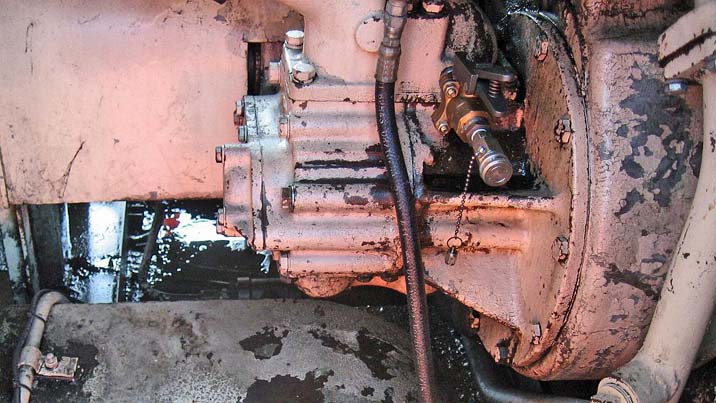 Diesel engine lube oil sample valve. All of the locomotive fleet was equipped with oil sample valves. The picture shows a typical application on a General Motors (GM) locomotive. It's a small valve that allows hot engine oil to be dispensed into a 100 millilitre (ml) sample bottle safely. The likes of air compressors did not have an easily accessible sample valve, so when samples were taken from them one had to use a Suck Gun. Sort of like a grease gun in reverse. A tube was dipped into the compressor crankcase and oil and sucked up into the gun. Then it was discharged into a sample bottle and sent to the lab. This is not a preferred way to take samples though. There can be debris from the bottom of the crankcase sucked up, and / or, there can be cross contamination between compressor samples taken by the same gun if it's not cleaned properly. 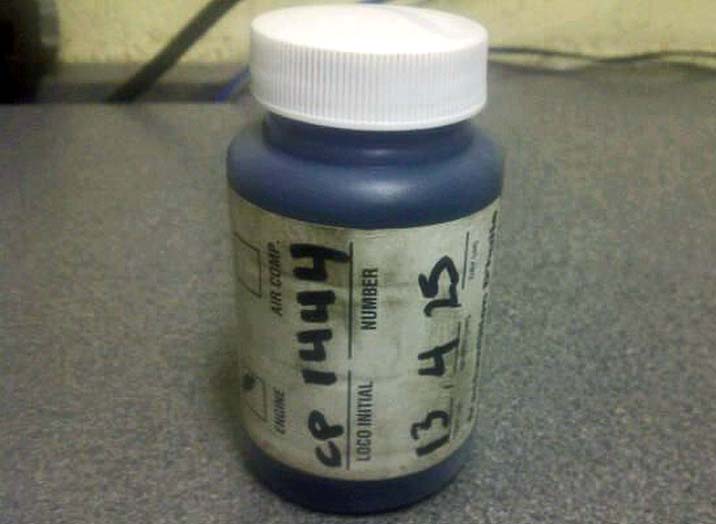 Poly plastic sample bottle. In any event, engine oil samples were taken from all locomotives as they passed through the shop fuel islands, when they came in for scheduled or unscheduled maintenance, on a scheduled basis for off-site captive units, or on an as-requested basis. Usually about once a week was the basic standard. Typically, a Shop Machinist took a clean 100 ml poly bottle and got a sample from the engine sample valve, marked the bottle, and submitted it to the lab PDQ (Pretty Damn Quick). The photo shows a current style sample bottle with a sample of oil taken on 25 Apr 2013. (The lids were smaller on the bottles used in the past). The lab would run the sample and get back to the shop supervisor right away if a problem was detected. Normally they'd get a second sample and re-run it just to ensure there wasn't a mix-up with the original. Once the lab got a sample they ran three basic tests. The first two are classified as Physical Tests, and the third is the Spectrometer Test. First they put a small amount of the oil from the sample bottle onto a Hot Plate. If it sizzled or popped there was free water in the oil so that had to be investigated. If it was raining heavily outside, which was standard on the Wet Coast, a second sample was taken. A single drop of water in the sample bottle would show up on the Hot Plate! 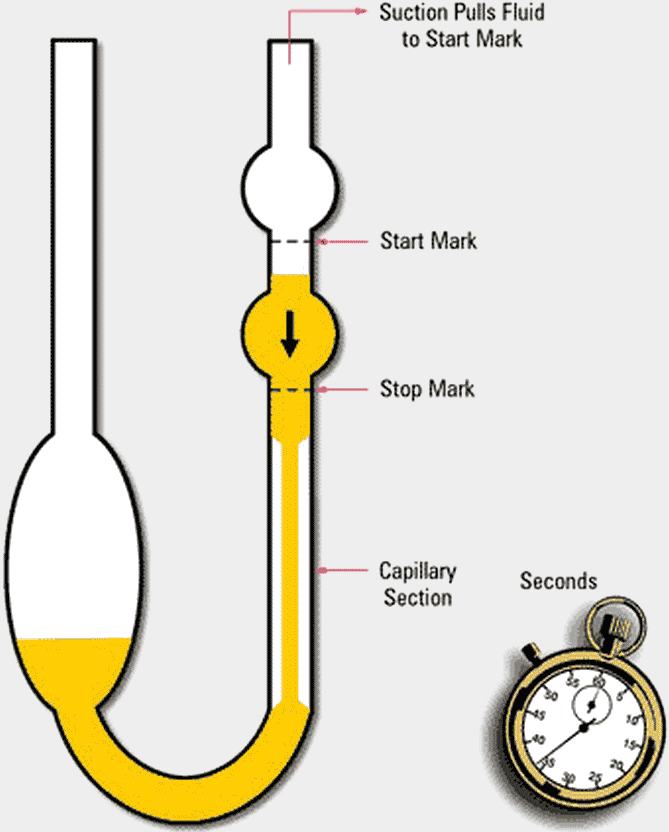 Glass Capillary Viscometer. The second test was to check the viscosity of the oil. (The viscosity of a fluid is a measure of its resistance to gradual deformation by shear stress or tensile stress. Phew! For liquids, it corresponds to the informal notion of thickness. For example, honey has a higher viscosity than water.) This was done by putting some oil from the sample bottle into a special Glass Capillary Viscometer tube similar to the drawing shown. These tubes had a calibrated orifice in them plus a Start and Stop Line marked on the tube. The tubes were dipped into a hot water bath that heated the tubes and the oil inside to exactly 40 degrees Celcius. Once stabilized, the oil is sucked with a small vacuum hose up past the Start Mark on the tube. The Technician releases the vacuum and times the oil as it drops back down the tube from the Start mark to the Stop mark. That recorded time is then converted to a viscosity number based on the starting weight of the lube oil, which in our case was Single Grade 40 Weight lube oil. If the speed of the oil dropping is the same as NEW oil, it has no loss of viscosity. But, if it runs faster than NEW oil it has lost some viscosity. Oil contaminated with diesel fuel from a bad injector or leaking fuel line will cause the oil to run faster, and depending on the severity would result in the engine needing to be checked over for internal fuel leaks. Anything over 5 percent fuel dilution is considered serious and would generate a High Level Lab Alert. We frequently found, that after an engine had injectors or fuel lines replaced, there were fuel leaks identified by this test. Many engines were saved from serious damage due to these leaks being detected by follow-up viscosity tests. High Viscosity can occur as well, but is far less frequent. If the engine lube oil were to be overheated it most likely would see an increase in viscosity. In both cases the oil and filters would require changing. 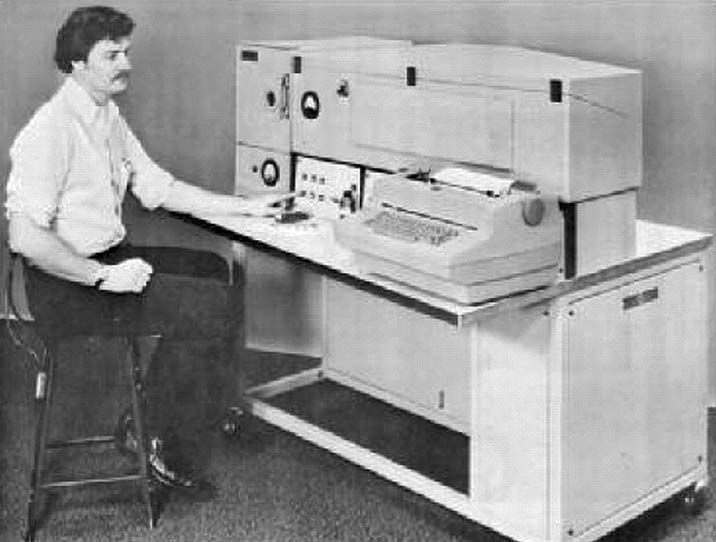 Baird FAS-2 Optical Emission Spectrometer. Finally, the oil would be tested for wear metals and a few other elements. Each lab was equipped with Baird FAS-2 Optical Emission Spectrometers as stated above. The picture shows what they look like. I won't go into the fine details of this machine, but suffice it to say they were very complicated internally and needed specialized care. The local Lab Tech's could do the basic maintenance on the machines, but specialists needed to be called in occasionally to sort out major issues. The US Navy were big users of these machines, and the Baird Service Technicians were frequently working on naval vessels when we needed their expertise. Thus it could take weeks to get a broken machine back in proper working order. The elements the machine would test for were: tin, lead, copper, aluminum, iron, chrome, boron, sodium, silver, zinc, calcium, silicon, and nickel. Each of these elements present in the lube oil either in single or multiple, and the quantities of each, would tell a trained person what may be going on in the locomotive engine. Just like a doctor can tell you've got a problem if your blood sugar is high. For example, high lead or copper may indicate excess bearing wear. Whereas high boron and sodium (in the absence of free water from the first Physical Test), would indicate a slow internal water leak since the cooling water is normally treated with a Borate Nitrite corrosion inhibitor. A high silicon reading would generally mean the engine air filters need replacing since dirt is getting into the engine. Frequently locomotives coming off overhaul had high silicon in the oil. My belief was the internal engine components were not properly cleaned of shot blasting grit before final assembly. But then, that's just my opinion for what it's worth. 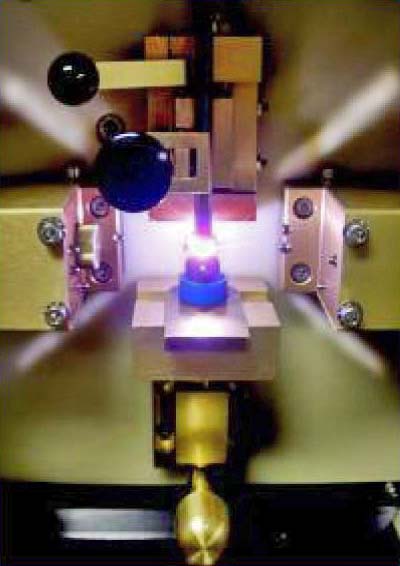 A high voltage arc in the spectrometer burn chamber. To test a sample in the Spectrometer the Lab Tech would first pour a small quantity of oil from the sample bottle into the lid of that bottle. Then they placed the lid of oil into the "burn chamber" of the machine (Upper left in the photo of the machine, and shown in blue in the photo of the exposed Burn Chamber). In the burn chamber are two electrodes. A small round carbon disc about half an inch in diameter mounted on a rotating shaft, and a carbon rod about the thickness of a pencil above that was a short distance from the disc. The sample bottle lid full of oil was placed under the rotating carbon disc, then once in place was raised up so the bottom of the rotating disc was in the oil. The door was closed and the start button pushed. A high voltage arc was applied between the disc and the carbon rod whilst the disc rotated in the oil sample, as per the photo. This caused the oil picked up by the disc to burn. The light from the burn was sent through an optic cable to a device that was somewhat like a prism where it then spread the light from the burn out over a number of Optical Sensors inside the machine. These optical elements were calibrated for the light signature of each wear metal being measured. The wear metals present are measured in Parts Per Million (PPM), and after a five or ten second burn has finished, internal electronics send the data received by these photo elements to the computer for the Technician to read. Once the test is complete the oil sample and the carbon disc are discarded. The carbon rod is also removed and can be reused by resurfacing the arc point. A new disc and rod may then be inserted into the burn chamber ready for the next sample. Both the spectrometer and the Viscometer tubes need to be calibrated every so often with known test oils. If any or all of the wear metal elements in the spectrometer are not giving the same readings that the test oils dictate, they must be recalibrated. Likewise, the Glass Viscometer Tubes may need to be remarked if out of whack. For example, over time the small capillary tube in the glass may open up due to corrosion or abrasion. Or they could accumulate debris, thus restricting the flow of oil. Either situation would throw the calibration of the tube off a tad. So the time factor number on the tube may need to be changed, or the tube discarded. These three tests were repeated for every sample that came through the lab, most of the time in batches to speed up the overall process. But individual tests would be done if required. All the test results were stored in the LMIS database and could be studied once enough samples had been run on a locomotive's engine oil to see if any trends were developing. If wear metals or viscosity readings were stable it may be okay to let the unit ride till the next maintenance shopping. If the readings were increasing quickly, they may order the unit be shut down to avert major engine damage. One of the key items that made this system work well was the fact GM engine oil was never changed on a formal basis. The GM engine used enough oil when in service that topping up was normal practice. So typically only the oil filters were changed at maintenance shoppings. This allowed for long running trend monitoring and analysis in these engines. Lube oil would typically be changed only in the event of water or fuel contamination. If the oil had excessive readings of wear metals such as copper or lead, it may be changed during an investigation or repair of the engine. The fact the oil was changed would be noted in LMIS and a new trend line would be developed. In my opinion these labs saved the railway stacks of money by preventing some major failures. These labs also did some other testing on a limited basis. As I noted above, locomotive air compressors also had their oil tested, but normally only on scheduled maintenance visits. Air compressors used lighter oil than the engines and also the oil has different properties than that of engine oil. For example, compressors don't run as hot as engines. Since they compress air they generate a lot of moisture that can get into the oil. Consequently, most compressor oils have a rust and oxidation additive to resist corrosion in the crankcase. They also have anti-foaming additives so the oil doesn't carry over into the compressed air system. Diesel fuel was also tested. The presence of water in fuel oil can cause damage to the fuel injectors of the engine. Water in the fuel oil can also harbour bacteria growth that can be a major problem. Once these bugs take hold of a fuel system the whole system has to be treated with a biocide such as borax that will kill the bacteria. The bacteria live in the water but feed off the oil. In the process they create a gelatinous slime that has to be removed, and this can be a major job. The labs had Bug Detector Test Kits that would indicate if bacteria were present in the oil. Water would typically get into the locomotive fuel system if the Fuel Heat Exchanger developed an internal leak. The heat exchanger used engine cooling water to heat the fuel oil in the tank. They also tested the fuel oil for the Cloud Pour Point. This test was primarily done on the fuel that was delivered to the facilities by various suppliers. Diesel fuel will "wax up" and the flow will diminish once the ambient temperature drops to specific points. Once a fuel reaches its Cold Filter Plug Point (CFPP), it can't get through the fuel filter. This point is about halfway between the Cloud point and the Pour point. Seasonally adjusted fuel is supposed to be delivered to the facilities depending on the time of year and ambient temperature conditions. A summer grade blend of fuel has a higher CFPP than a winter blend which has Cold Flow Improvers added to lower the CFPP. Many times the lab discovered the fuel being delivered in the late fall or early winter was not in spec for the time of year. When the supplier was notified they frequently replied that the fuel was okay for the local climate. But we had to remind them that our locomotives travelled all across the country. So while it may be a balmy above freezing climate on the West Coast, not too far east it could be a bone chilling well-below-zero scenario. A summer blend of fuel supplied in the middle of winter might cause grief to locomotives east of the West Coast. However, as long as those heat exchanges as mentioned above were working properly there wouldn't be a problem. But in many cases they were not functioning because of leaks and were shut off. So in these cases it was important for the fuel oil to be properly seasonally adjusted. All this work the labs performed helped support the fleet of locomotives for many years. The cost of operating labs surely prevents many expensive engine failures. Andy Cassidy 
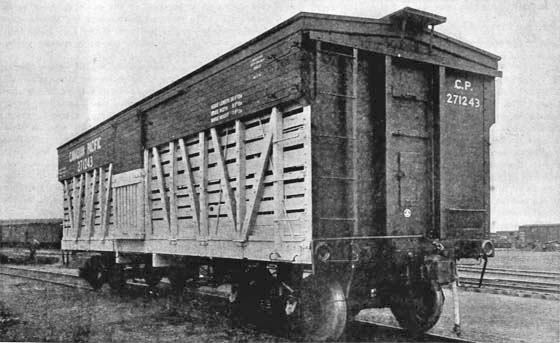 Thirty-ton Stock Car, Canadian Pacific Ry. Stock car construction, while at all times consisting of considerable variations in design of details such as method of securing the side framing to the side sills, etc., has always followed the same general lines of wooden underframe and decking with side posts and braces similar to box cars, but modified to suit the application of heavy slats on the inside only. When bay racks are used, however, it is customary to apply sheathing outside bay racks. The fact that so-called stock cars are used for many other kinds of freight, such as lumber, rails, ties, pulpwood, pipe, etc., seems to have been ignored by many designers and builders. As a matter of fact, if a careful check was made on some roads they would find stock cars were used for this class of traffic considerably more than for live stock. Even though the percentage of this traffic does not run high, the ends of stock cars will, on the average, receive more severe end shocks than box cars because, with the exception of rails or similar loads of steel, the majority of the materials handled are piled high in the car and some of them, particularly pipe and pulpwood, are slippery, which causes them to produce very heavy shocks, while, on the other hand, box cars being used for a greater variety of lading, do not so frequently have a load of this description. This condition is not taken care of in many designs, some of which have been recently described in railway papers, and for this reason the accompanying illustrations of the latest type of car built by the Canadian Pacific will be of interest as showing how a very substantial end may be easily and economically applied to car of otherwise standard construction. This car is of a standard design that has given excellent service for some years, except that more recently all the new cars have been constructed with steel center sills in connection with reinforced ends, as illustrated in the drawing, to eliminate draft gear troubles.
The end construction is practically identical with the latest 40-ton steel frame box cars, same consisting of two 5 inch 11.6 pound Z bar end posts, heavy angle corner posts, a 5 inch 11.6 pound Z bar end plate securely attached to end post, and corner posts securely attached to wooden side plate by means of gussets taking several bolts through the timber. The lower ends of the end posts are connected to the sill plate passing over the top of the wooden end sill and riveted to the steel center sill, thereby securely uniting the center sill construction and end framing. The end lining consists of 2 3/8 inch T.&G. (tongue and groove?) pine or spruce for a distance of 4 feet above flooring, with 1 3/4 inch thickness the balance of the height. This construction produces a car that is economical in first cost and will satisfactorily withstand usual service conditions either for stock or other service, and if damaged in accident can be easily and cheaply repaired. The last order of these cars were equipped with socket castings inside of slats to support temporary decks. This temporary deck is so designed that if similar castings are applied, the same deck will be interchangeable in any 36-foot car. When these castings are applied to a car, the sheathing board immediately below the fascia is removed to provide ventilation for lading carried in upper deck. This alteration does not show in the illustration as the photograph was taken before the board was removed.

The origin of fire clay, its general composition. The burning of coal, and the effect of a brick arch in securing desirable results.
To many it may seem like an odd coincidence that the material of a fire-brick arch, in the firebox of a locomotive, which stands above the glowing mass of burning white hot coal, was in distant geological times formed immediately below the coal seam, which in fact rested upon the "underclay". It is, however, more than a coincidence, as a glance at the history of the formation of coal and fire clay in Nature's workshop will show. The firebox of a working locomotive holds not only the highly inflammable material derived from the carboniferous period, but it also contains the most refractory substance known to science, and which had long been deposited in close association with the fuel, and in the same coal measures, of which it also was a product. The formation of coal in swampy localities was effected by the gradual subsidence of the soil, and as it sank down it carried with it dense forest growths which flourished in the damp, warm, air heavily charged with carbon dioxide, an essential of vegetable life. While the plants thrived, the ground on which these luxuriant forests grew was constantly drawn upon by the plants for those constituents required for their existence, and thus the soil was gradually depleted, and left purer, as far as the formation of clay was concerned. The process of rendering the soil free from what we call impurities was aided by the rapid growth of the vegetable life which it supported and eventually by the percolation through the soil of organic solvents from above, by which most of the lime and the alkalis were removed. The clay formation below the coal seam represents the ground upon which the plants originally grew, and it was to a certain extent, cleared, by the withdrawal of such mineral matter as was required by the plant and it was further refined by the solvent action of water or dilute acids.
Fire clay is thus not only closely associated with the formation of coal, but its origin is part of the whole process in nature, which gave us the coal measures. When the process of coal formation took place in tranquil lakes, trees and other vegetable matter was constantly washed down the steep shore slopes into the land-locked lake, as described in the December, 1915, issue of the Railway Master Mechanic, page 393. The fine dust and the surface earth which had already surrendered its plant-sustaining ingredients was carried from the land by rain, and wind, and stream. In this state fine particles of "mud" were deposited on the floor of the lake, previous to the sinking of the water-logged plants and trees which had floated out on the surface of the lake, and which were finally turned into coal.
The fire clay which we use today and which goes into the manufacture of locomotive arch brick, is of the highest quality obtainable, as it is recognized that the service required of it is the most severe to which refractory materials are subjected. Fire clay is for the most part composed of silica and alumina, and is, as a chemist would say, the silicate of alumina. An average of four independent analyses gives the amount of silica at about 52 percent and alumina at about 35 percent. The other constituents, consisting of lime, magnesia, potash, peroxide or iron, a little soda, and some water, are present in small quantities. The heat-resisting qualities of this fire-clay are practically assured by the work of nature in the formation of the clay, which has been reduced to an inert and highly refractory mass, but the service conditions call for the existence of several qualities over and above those which prevent melting. A locomotive arch requires to be composed of bricks sufficiently strong, not to break readily and to stand handling. The brick has to resist the powerful action of intense heat rapidly applied, and the violent contraction caused by cold air, suddenly thrust on and around it. It has also to withstand the continuous, heavy, abrasive action of a strong and steady flame, bearing particles of unburnt coal, soot, or smoke and the finely divided solid matter which forms part of the ash. It has to stand this abrasion, carried along under and over it, the heated stream having a velocity greatly exceeding that of a violent sand storm, urged on by a hurricane. The problem is therefore to prepare the fire brick so that it will meet these conditions, while preserving the heat-resisting qualities supplied by nature. The fire brick is made with sufficient strength not to break in the ordinary handling incident to the putting in or the removal of the brick. In order to save time when repairs have to be made, the P.R.R. issue asbestos gloves to the men who do this work, which permit a hot section of the arch to be taken out without hurt to the man or injury to the brick. The hot brick, when taken out, can then cool, as the faculty of "giving" a little under temperature changes is one of the satisfactory qualities it possesses.
Plastic fire clay is first mixed with some very hard or flint clay. This is used on account of its heat resisting qualities, and when mixed with plastic fire clay gives the necessary porosity to the finished product. This enables it to withstand violent changes of temperature, by affording the whole mass a chance for minute interior expansions and contractions which obviate the danger of cracking. The porous clay mixed in, adds the bonding quality to hold the brick together and gives it the resistance to abrasion, which is a necessary characteristic of its usefulness. The flint clay, during the vicissitudes of geological time has been very finely ground up and has become compressed into a hard mass. It breaks with a concoidal fracture, which is another way of saying that it separates in a series of convex elevations and concave depressions, and is in itself close grained and dense.
When the mass of plastic and flint clay have been kneaded and formed into bricks, they are fired in a kiln, and here the utmost care is taken in the process, so that the brick may be burned and become a highly serviceable commercial product, possessed of the qualities which will enable it to oppose the action of intense heat, stand sudden cold, and resist powerful abrasive action. Having secured such a substance in useful commercial size and form, one may, with propriety, glance at the function it is intended to perform in a locomotive firebox and thus get an outline view of the whole matter. In 1885 Mr. James N. Lauder, then master mechanic of the Old Colony Railroad, made a series of tests to ascertain the value of the brick arch. His conclusion was that the arch produced a saving of coal. This conclusion is borne out by subsequent tests and the experience of many. To understand the rationale of the coal saving process, it is necessary to consider some of the general principles of coal combustion. Coal is composed in the main of fixed carbon which in burning, combines with the oxygen. It requires a full supply of that gas and when burning, glows intensely and gives off CO2, with little or no smoke. Coal, however, also contains carbon in combination with hydrogen, and this forms, when distilled from the solid coal, a series of allied gases each with a different igniting temperature and requiring various quantities of oxygen. These are the carbohydrates or volatile gases, also called the hydrocarbons, which contribute a large amount of heat when properly burnt, but they are easily lost, and when not consumed, tend to lower the firebox temperature. In order to liberate the hydrocarbons, it is necessary that heat be applied to distill them from the coal and drive them off in the form of hot gas. When they are thus liberated, they split up into the members of the series of gases to which they belong, and they have then to be supplied with appropriate quantities of oxygen. All this takes some appreciable time and requires a most thorough mixing of gas and air. Just here an analogy between the process of feeding, adopted by thoughtless mankind, and that of the rapidly expelled hydrocarbons, readily strikes the imagination. The gases given off near the flue sheet are drawn into the tubes at once with little or no time to be properly burnt. The gases from under the fire door take a slightly longer time before they are sucked into the tubes, but in either case the time is too brief to properly allow for their combining with the oxygen of the air, and the engine, like the unwisely hurried man, bolts its food. The brick arch interposes an inclined baffle wall above the grate, which practically doubles the length of the flame-way and increases the time required for the proper mixing of the hydrocarbons with the oxygen of the air. This fact spells "coal-saving" by causing the fuel to give out more heat to the pound, and it therefore enhances the value of every square foot of heating surface in the boiler.>/p>
With hand-fired engines a remarkably good result comes incidentally with the use of the arch. In order to get coal into the firebox the fire door must be opened a great many times on the trip. Every time the door is opened a stream of cold air enters the firebox, and as it were, entirely cuts out a volume of hot gases already performing its function. The cold stream chills the tubes and reduces the temperature of the firebox at the very time that the hydro-carbons are being distilled from the coal and when heat is essential. This undesirable condition is practically eliminated by the brick arch, for by its shape it directs a flow of hot gas against entering cold air, and instead of permitting the cold inflow to take its curved, but unobstructed sweep to the upper tubes, it causes the hot firebox gases to surge against, around and through it, and before it reaches the flue sheet it has become, with the oxygen, a useful part of the intensely hot gases, which enter the tubes and ultimately deliver their heat to the water. Practically the same result takes place when a hole in the fire develops, and although neither of these contingencies are desired in locomotive operation, they recur from time to time and the presence of the brick arch acts with beneficial counter play and greatly minimizes, if it does not entirely eliminate, the loss which would otherwise take place.
In making the brick for locomotive use, the underside is formed with a series of pockets something like what foundry men would call "lightening cores". This is done with the important object of presenting a roughened surface over which the gas is rolled and in so doing thoroughly mixes the hydrocarbons with air. It incidentally lightens the brick, and requires less material. Reverting to our simile once more, we may say that these gases and the oxygen are not "bolted", but thoroughly "masticated" before entering into what corresponds to the alimentary canal of the iron horse. The brick arch as displayed in one of our illustrations shows a slight appearance as if a solid drip had just begun. The presence of icicles, or if we may change to a more appropriate word, we may say the stalactites on the underside of the brick, are not due to a tendency of the brick material to melt or "run". They are caused by impure emanations from the coal, such as ash and slag, which are carried up by the strong rush of flame, adhere to the underside of the brick, and are more slowly fused in the intense heat. They thus add to the roughening of the underside of the brick and contribute to the gas and air the mixing action secured by the pockets which are a part of the design of the brick. The locomotive arch is based on scientific principles and performs a useful function in a locomotive, where coal is burned in larger quantity per square foot of grate area than in any other form of furnace. The area of the grate is hardly larger than an ordinary dining-room table, yet within the closely set walls and ends of the box, the fire rages, urged to the greatest intensity by forced draft, which can be varied as the engineman alters the position of the reverse lever. In this white hot storm the brick arch mixes the gases arising from the coal, and remains itself intact, while it lengthens the flame-way and delays the exit of the heated gas, so that cinders are greatly reduced, while it curtails the formation of smoke, and as far as may be, all the heat represented by the burning of the coal is applied to the generation of steam. These facts lead naturally to the conclusion, verified by the statements of men familiar with conditions and with locomotive performance, that the brick arch not only saves coal, but gives a greater sustained horse power, permits less smoke to form, maintains the flues in better shape and with fewer stoppages and cloggings, and causes them to last longer and that, as a consequence, fewer steam failures occur. The most important feature, depending on the more thorough burning of coal, which the brick arch permits and following naturally from the coal saving, is the increased and sustained horse power now within reach. A pound of coal gives off a certain quantity of heat when burned. The more perfectly the combustion is effected the more available heat there is, part is not lost by rapidly rushing out of the stack, nor is it stifled at the start and forced to uselessly produce soot and smoke. The brick arch provides a way for all the available heat units to seek the one object, that of boiling water under pressure, and so increasing the capacity of the engine for doing useful work. It is like the difference between dragging at a stone with the hands or using a lever to move it. The locomotive is not now the crude machine of twenty-five years ago, when the ability to haul cars even at a wasteful cost was permitted. Today the object of the master mechanic and his staff is not only to haul cars, but to do it economically by the employment of scientific methods. Based on the knowledge of what combustion really is, and how the exacting conditions of modern locomotive service have to be met, and how difficulties are to be overcome, the locomotive of today is in the hands of intelligent railroad mechanical officers and men, is making substantial progress, and may in time approximate to an instrument of precision. 
Throuth the courtesy of Mr. E.A. Williams, superintendent of rolling stock, we show the accompanying illustration and give the following description of some new locomotives recently purchased by the Canadian Pacific Railway Company from the American Locomotive Company. The total weight of the locomotive illustrated is 159,500 pounds, the weight on the drivers being 140,500 pounds, and on the truck 19,000 pounds. The weight of the tender is 114,000 pounds, making a total weight of engine and tender 273,500 pounds. The locomotives were built at the Schenectady Works of the American Locomotive Company. The general dimensions are as follows: Wheel base of engine - 23 feet 7 inches. Tender Tank capacity, Water - 5,000 imperial gallons. The special equipment includes a Westinghouse American combined brake on engine and tender for train, 9 1/2 in. air pump, Franklin sectional asbestos block boiler lagging, Leach sand feed, two Crosby pop safety valves, two Detroit sight feed lubricators, United States metallic packing. Tyres Krupp crucible, Washburn couplers, Star head lamp, McCord M.C.B. journal boxes, A. French & Co.'s springs, Sterlingworth reinforced brake beams, two No. 10 Gresham and Craven automatic restarting injectors.
|
